When I first created this Mushroom Sisig recipe, I was skeptical that mushrooms could truly capture the magic of my Lola's traditional pork version that I grew up enjoying at family gatherings in Bataan. But after one bite of these perfectly roasted mushrooms, tangy with vinegar, bright with kalamansi, and with that satisfying textural contrast we Filipinos treasure in authentic sisig, I was instantly transported back to those sizzling platters shared with loved ones.
This plant-based adaptation has become my go-to dish when hosting friends, whether served cold as pulutan alongside ice-cold San Mig beer or hot on a dramatic sizzling plate for special occasions.
The best part? It captures all the bold flavors of home while being something everyone can enjoy together.
What is Mushroom Sisig?
Mushroom Sisig is a flavorful plant-based adaptation of the traditional Filipino dish. This version maintains the authentic taste profile and textural elements of classic sisig while being completely vegan. It balances tangy, savory, and slightly spicy notes in a dish that can be enjoyed either as a cold salad (honoring sisig's 17th-century roots) or as a sizzling hot plate that pays homage to the modern evolution popularized by Aling Lucing, the legendary "Sisig Queen" of Pampanga.
The term "sisig" or "manisig" traditionally means to cook or season something with sour elements like vinegar and calamansi. Our mushroom version creates a beautiful medley of textures and bold flavors that makes it perfect as either a main dish or as pulutan (food paired with drinks).
Jump to:
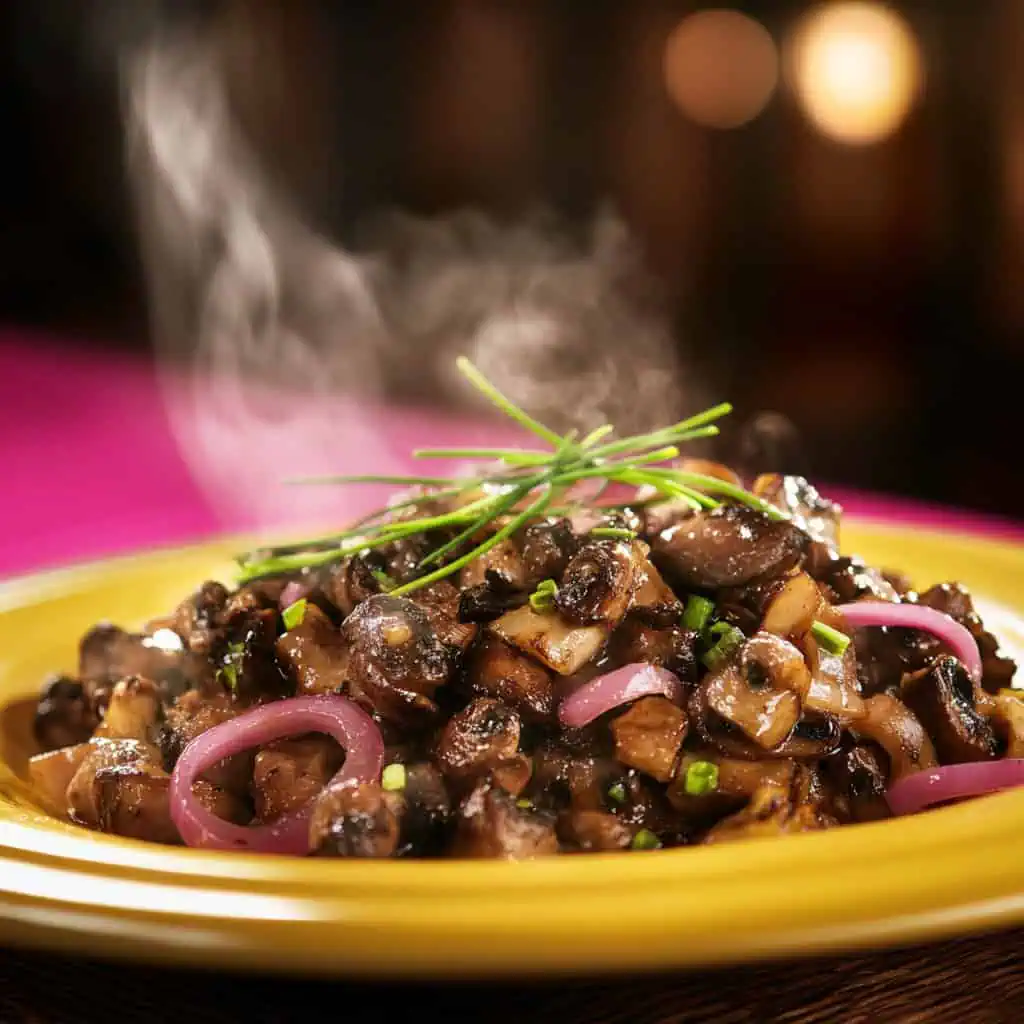
Why You'll Love This Recipe
- Authentic Filipino Flavors: Experience the true essence of sisig with its perfect balance of sourness, umami, and optional heat
- Versatile Serving Options: Enjoy it cold as a refreshing salad or hot on a sizzling plate for dramatic presentation
- Plant-Based Goodness: A healthier alternative that doesn't compromise on the rich, satisfying mouthfeel of traditional sisig
- Textural Symphony: The combination of different mushroom varieties creates a delightful mix of textures
- Quick Preparation: Ready in under 30 minutes with minimal hands-on time
- Crowd-Pleaser: Impresses both vegans and meat-eaters alike with its bold flavors
- Customizable Heat Level: Easily adjust the spiciness to suit everyone at your table
Ingredients
This recipe carefully selects blue oyster and cremini mushrooms for their meaty texture and ability to mimic traditional sisig's characteristic chew. The combination of vinegar and calamansi juice creates that essential Filipino sour profile, while coconut aminos adds umami depth without overwhelming the delicate mushroom flavor.
Pickled red onions provide both tanginess and a beautiful pop of color. The vegan mayonnaise introduces a subtle creaminess that balances the acidic elements, recreating the richness found in traditional versions without any animal products.
Together, these ingredients honor authentic Filipino sisig's complex flavor profile while creating a completely plant-based dish that satisfies both vegans and meat-eaters.
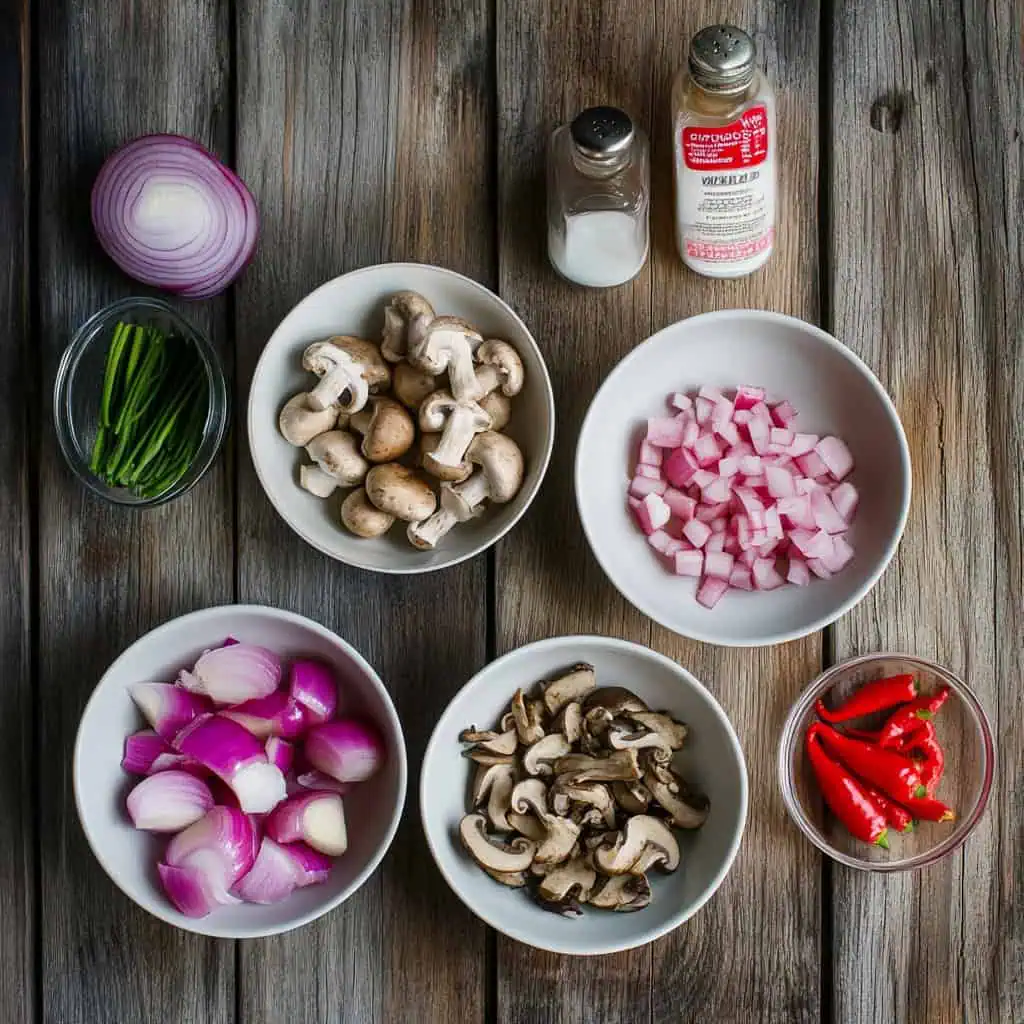
For the Mushrooms:
- 1 pound Blue Oyster Mushrooms (provides meaty texture and won't shrink excessively)
- 1 pound Cremini Mushrooms (adds earthy flavor and firm bite)
- 2-3 tablespoons Olive Oil
- Salt and pepper, to taste
For the Seasoning:
- 1 Large Red Onion, finely diced
- ¼ Cup Vinegar (authentic Filipino vinegar is essential for proper flavor)
- 2 Tablespoons Coconut Aminos (adds umami and light color)
- 2 Tablespoons Calamansi Juice (provides essential citrus tang)
- 1 Tablespoon Vegan Mayonnaise (creates creaminess)
- 1 Tablespoon Chopped Chives or Green Onion, plus extra for garnish
- Red Pepper Flakes, Hot Sauce, or Fresh Chopped Chili to taste (optional)
Equipment
- Baking sheet: For roasting the mushrooms to develop deep umami flavors
- Sharp knife and cutting board: For precise chopping of mushrooms and vegetables
- Mixing bowls: For pickling onions and combining ingredients
- 8-inch Cast Iron Skillet: For the traditional sizzling presentation (creates that authentic restaurant experience)
- Wooden Board or Trivet: To safely serve the hot skillet without damaging your table
- Measuring spoons and cups: For precise portioning of ingredients
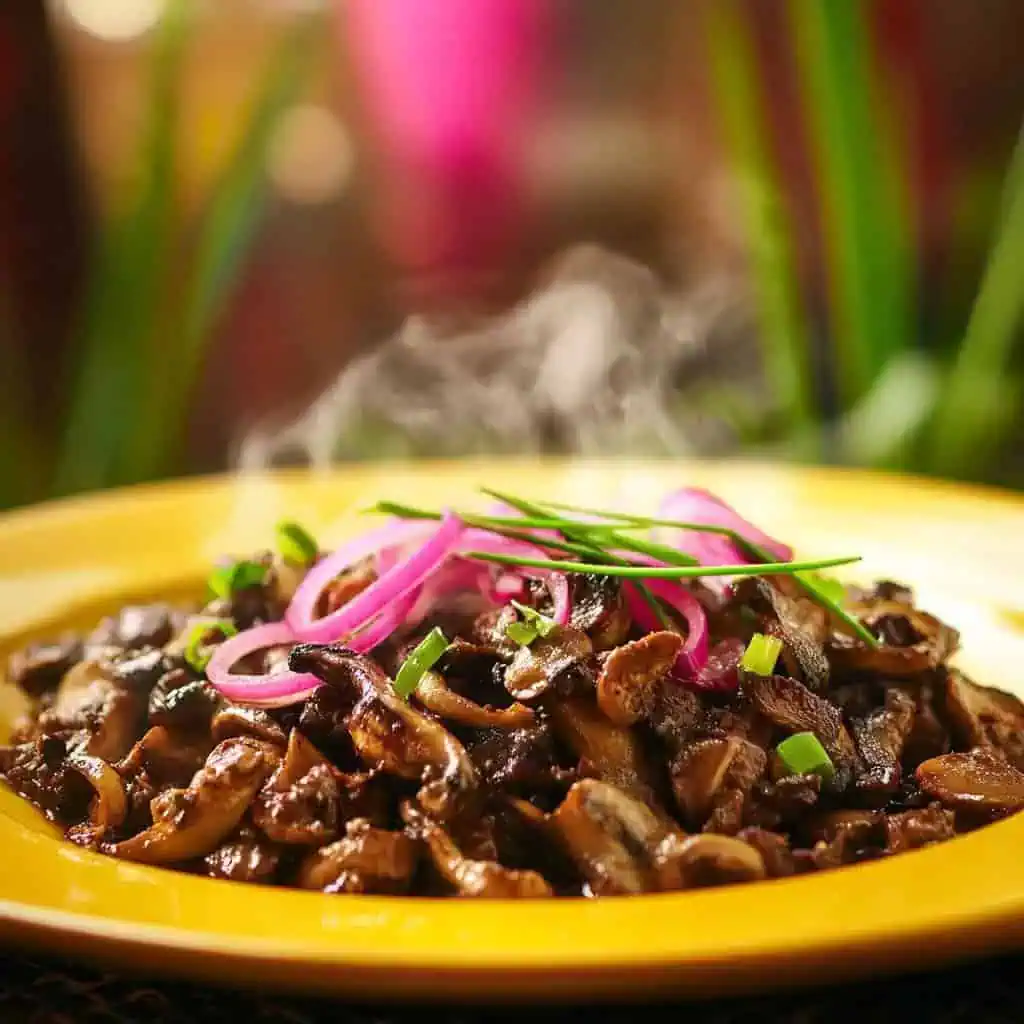
How To Make
- Start by finely dicing the red onions and placing them in a small bowl. Pour ¼ cup of vinegar over the onions and let them sit while you prepare the mushrooms, about 20 minutes until they turn pink. This mellows the raw onion flavor while adding a nice tangy brightness.
- Preheat your oven to 375°F (190°C). Wash and thoroughly dry your mushrooms – this is important for proper roasting. Arrange the mushrooms in a single layer on a baking sheet, making sure not to overcrowd them. Use two baking sheets if needed. Drizzle approximately 2-3 tablespoons of olive oil over the mushrooms and season generously with salt and pepper.
- Roast the mushrooms for 10 minutes, then take them out and flip them over. Continue roasting for another 10 minutes until they're golden brown and slightly crispy at the edges. Remove from the oven and let them cool to room temperature. Once cooled, chop the mushrooms into small, bite-sized pieces and transfer them to a large mixing bowl.
- To the bowl of chopped roasted mushrooms, add 4 tablespoons of the pickled onions including some of the vinegar, 2 tablespoons coconut aminos, 2 tablespoons calamansi juice, 1 tablespoon vegan mayonnaise, and 1 tablespoon of chopped chives or green onion. If you want some heat, add your preferred amount of red pepper flakes, hot sauce, or fresh chilies. Mix everything thoroughly until all flavors are well combined. Taste and adjust the seasoning with salt, pepper, additional vinegar, or calamansi juice as needed. For best flavor, let the mixture rest for 5-10 minutes before serving.
- For cold serving (like a salad), simply transfer the mixed sisig to a serving platter. Garnish with additional pickled onions and chopped chives or green onions. Serve with extra hot sauce or chili on the side for those who like more heat.
- For hot serving on a sizzling skillet, heat an 8-inch cast iron skillet over medium-high heat until very hot. Drizzle a tablespoon of olive oil into the hot skillet. Add the prepared mushroom sisig mixture to the skillet and cook for approximately 2 minutes, stirring occasionally to heat everything thoroughly. Carefully place the hot skillet on a wooden board or heat-resistant surface. Garnish with additional pickled onions and chopped herbs. Serve immediately while the skillet is still sizzling for that authentic restaurant experience.

Tips from Lola's Kitchen
- Mushroom Selection: Using a combination of mushrooms creates various textures, mimicking the textural complexity of traditional sisig
- Thorough Drying: Ensuring mushrooms are completely dry before roasting prevents steaming and encourages browning
- Temperature Control: The 375°F oven temperature is perfect for developing flavor without burning
- Pickling the Onions: This step not only mellows the harshness of raw onions but infuses them with tangy notes that complement the dish
- Flavor Layering: The combination of vinegar, calamansi, and coconut aminos creates depth without overwhelming the mushroom flavor
- Roasting Technique: Single-layer roasting ensures each mushroom gets perfectly caramelized for maximum flavor
- Rest Before Serving: Allowing the mixture to rest for 5-10 minutes helps the flavors meld together beautifully
- Sizzling Presentation: For the most impressive presentation, make sure your cast iron skillet is smoking hot before adding the sisig
Substitutions
- Mushrooms: If blue oyster mushrooms aren't available, use king oyster, shiitake, or portobello mushrooms
- Coconut Aminos: Can substitute with low-sodium soy sauce or liquid aminos
- Calamansi Juice: If you can't find calamansi, use 1½ tablespoons lime juice + ½ tablespoon lemon juice
- Vegan Mayo: Regular mayonnaise works for a non-vegan version, or try cashew cream for another plant-based alternative
- Filipino Vinegar: White wine vinegar or apple cider vinegar can work in a pinch
- Fresh Herbs: Cilantro works well as a substitute for chives or green onions
- Heat Element: Sriracha, sambal oelek, or any chili paste can replace fresh chilies
Troubleshooting
- Mushrooms too watery? Make sure to thoroughly dry before roasting and don't overcrowd the baking sheet
- Flavor not tangy enough? Add more calamansi juice or vinegar in small increments
- Too sour? Balance with a touch more vegan mayo or a pinch of sugar
- Lacking umami depth? Try adding an extra teaspoon of coconut aminos or a small amount of mushroom powder
- Not crispy enough for sizzling presentation? Ensure your skillet is extremely hot before adding the sisig mixture
- Mushrooms shrinking too much? Cut them into slightly larger pieces before roasting
- Texture too homogeneous? Try using an additional mushroom variety for more textural contrast
Storage & Reheating
- Refrigeration: Store leftovers in an airtight container for up to 3 days
- Freezing: Not recommended as the texture of mushrooms will deteriorate
- Reheating: For best results, reheat in a hot skillet with a small amount of oil until just warmed through. Avoid microwave reheating as it can make the mushrooms rubbery
- Rejuvenating leftovers: Add a splash of fresh calamansi juice and a sprinkle of fresh herbs when reheating to brighten the flavors
- Cold enjoyment: Leftovers can be enjoyed cold as a salad topping or sandwich filling
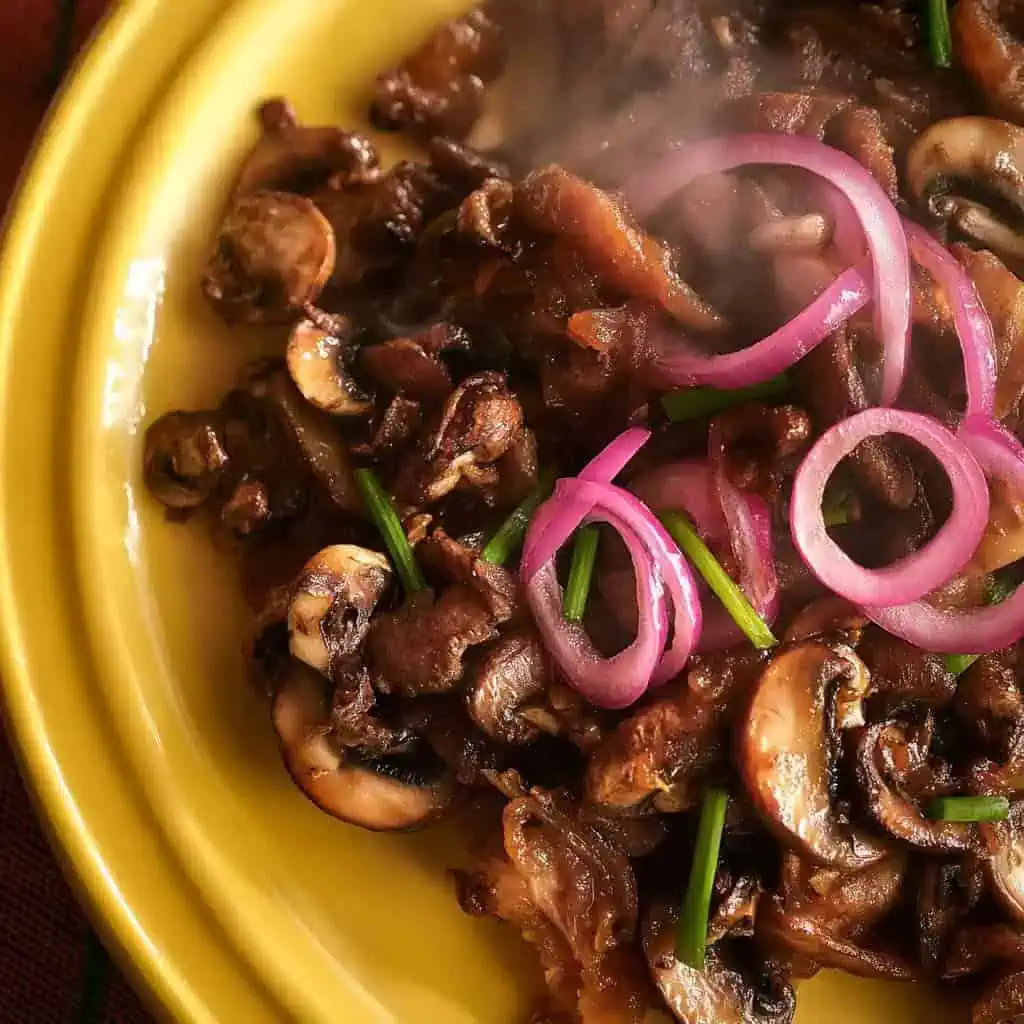
FAQ
What does "sisig" mean?
The term "sisig" or "manisig" in Filipino cooking refers to marinating or seasoning something with acidic ingredients like vinegar and citrus juice.
Is mushroom sisig healthier than traditional sisig?
Yes! Traditional sisig is typically made with pig parts including face, ears, and liver. This mushroom version is lower in fat and cholesterol while being rich in fiber, antioxidants, and nutrients.
Can I make this dish ahead of time?
Yes, you can prepare all components up to 24 hours ahead. For best results, store the roasted chopped mushrooms and pickled onions separately, then combine and season shortly before serving.
Which mushrooms work best for sisig?
Mushrooms with meaty textures work best. Blue oyster, cremini, king oyster, and portobello are excellent choices as they maintain their structure during cooking.
How can I make this more authentic?
Using genuine Filipino ingredients like Datu Puti vinegar and fresh calamansi juice will give you the most authentic flavor. Serving on a sizzling plate also enhances the traditional experience.
Is this recipe truly vegan?
Yes, all ingredients in this recipe are plant-based, making it suitable for vegans and vegetarians.
How spicy is this dish?
The base recipe is mild, but you can adjust the heat level by adding more chili or hot sauce according to your preference.
Can I serve this as a main dish?
Absolutely! Pair it with steamed rice for a complete meal. It also works wonderfully as an appetizer or party dish.
What drinks pair well with mushroom sisig?
Cold beer is the traditional pairing, but it also goes well with crisp white wines, calamansi juice, or cucumber-based mocktails.
How can I make this dish more substantial?
You can add firm tofu, chickpeas, or even jackfruit for additional protein and texture.
Related
Looking for other recipes like this? Try these:
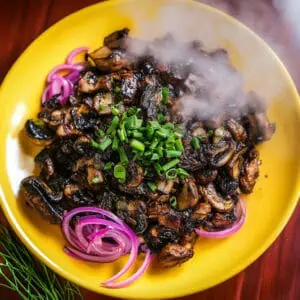
Authentic Mushroom Sisig
Equipment
- Baking sheet For roasting the mushrooms to develop deep umami flavors
- Sharp knife and cutting board or precise chopping of mushrooms and vegetables
- Mixing bowls For pickling onions and combining ingredients
- 8-inch Cast Iron Skillet For the traditional sizzling presentation (optional but recommended for authentic experience)
- Wooden Board or Trivet To safely serve the hot skillet
- Measuring spoons and cups For precise portioning of ingredients
Ingredients
For the Mushrooms
- 1 pound Blue Oyster Mushrooms Provides meaty texture and won't shrink excessively
- 1 pound Cremini Mushrooms Adds earthy flavor and firm bite
- 2-3 tablespoons Olive Oil
- Salt asin and at paminta, to taste
For the Seasoning
- 1 Large Red Onion pulang sibuyas, finely diced
- ¼ Cup Vinegar suka - Authentic Filipino vinegar is essential for proper flavor
- 2 Tablespoons Coconut Aminos Adds umami and light color
- 2 Tablespoons Calamansi Juice katas ng kalamansi - Provides essential citrus tang
- 1 Tablespoon Vegan Mayonnaise Creates creaminess
- 1 Tablespoon Chopped Chives or Green Onion dahon ng sibuyas, plus extra for garnish
- Red Pepper Flakes Hot Sauce (sawsang maanghang), or Fresh Chopped Chili (siling tuyo) to taste (optional)
Instructions
- Start by finely dicing the red onions and placing them in a small bowl. Pour ¼ cup of Datu Puti vinegar over the onions and let them sit while you prepare the mushrooms, about 20 minutes until they turn pink. This mellows the raw onion flavor while adding a nice tangy brightness.
- Preheat your oven to 375°F (190°C). Wash and thoroughly dry your mushrooms – this is important for proper roasting. Arrange the mushrooms in a single layer on a baking sheet, making sure not to overcrowd them. Use two baking sheets if needed. Drizzle approximately 2-3 tablespoons of olive oil over the mushrooms and season generously with salt and pepper.
- Roast the mushrooms for 10 minutes, then take them out and flip them over. Continue roasting for another 10 minutes until they're golden brown and slightly crispy at the edges. Remove from the oven and let them cool to room temperature. Once cooled, chop the mushrooms into small, bite-sized pieces and transfer them to a large mixing bowl.
- To the bowl of chopped roasted mushrooms, add 4 tablespoons of the pickled onions including some of the vinegar, 2 tablespoons coconut aminos, 2 tablespoons calamansi juice, 1 tablespoon vegan mayonnaise, and 1 tablespoon of chopped chives or green onion. If you want some heat, add your preferred amount of red pepper flakes, hot sauce, or fresh chilies. Mix everything thoroughly until all flavors are well combined. Taste and adjust the seasoning with salt, pepper, additional vinegar, or calamansi juice as needed. For best flavor, let the mixture rest for 5-10 minutes before serving.
- For cold serving (like a salad), simply transfer the mixed sisig to a serving platter. Garnish with additional pickled onions and chopped chives or green onions. Serve with extra hot sauce or chili on the side for those who like more heat.
- For hot serving on a sizzling skillet, heat an 8-inch cast iron skillet over medium-high heat until very hot. Drizzle a tablespoon of olive oil into the hot skillet. Add the prepared mushroom sisig mixture to the skillet and cook for approximately 2 minutes, stirring occasionally to heat everything thoroughly. Carefully place the hot skillet on a wooden board or heat-resistant surface. Garnish with additional pickled onions and chopped herbs. Serve immediately while the skillet is still sizzling for that authentic restaurant experience.
Tips from Lola's Kitchen
- Mushroom Selection: Using a combination of mushrooms creates various textures, mimicking the textural complexity of traditional sisig
- Thorough Drying: Ensuring mushrooms are completely dry before roasting prevents steaming and encourages browning
- Temperature Control: The 375°F oven temperature is perfect for developing flavor without burning
- Pickling the Onions: This step not only mellows the harshness of raw onions but infuses them with tangy notes that complement the dish
- Flavor Layering: The combination of vinegar, calamansi, and coconut aminos creates depth without overwhelming the mushroom flavor
- Serving Options: The flexibility to serve either cold or hot makes this dish perfect for any season or occasion
Nutrition
The Story Behind Mushroom Sisig
Sisig's journey through Filipino culinary history is as flavorful as the dish itself. The word "sisig" comes from an ancient Kapampangan term "manisig," which means "to make something sour" or "to marinate with vinegar." In the 17th century, sisig was actually a simple salad made from green papaya or guava dressed with vinegar and spices. This tangy dish was popular in the Pampanga region, which has long been considered the culinary capital of the Philippines.
The modern version of sisig that most Filipinos know today has a fascinating origin story tied to resourcefulness and innovation. In the 1970s, Lucia Cunanan—affectionately known as "Aling Lucing" or the "Sisig Queen"—created what would become the country's beloved sizzling sisig in Angeles City, Pampanga. Her invention was born from necessity and creativity, using discarded pig parts from the nearby Clark Air Base where American servicemen were stationed. She boiled, grilled, and chopped these unwanted parts (face, ears, and liver), seasoned them with vinegar, calamansi, onions, and chili peppers, and served the mixture on a sizzling hot plate.
This sizzling version quickly became a sensation, particularly popular as "pulutan"—food enjoyed with alcoholic drinks like beer. The combination of crispy, chewy textures with bold, tangy flavors made it the perfect companion to ice-cold San Miguel beer. As sisig's popularity spread throughout the Philippines, regional variations emerged, with seafood, chicken, and even tofu versions appearing on menus across the country.
Our mushroom sisig honors this rich culinary heritage while offering a plant-based alternative that captures the dish's essential elements: contrasting textures, bright acidity, and that unmistakable sizzle. By using different mushroom varieties and traditional Filipino ingredients like calamansi and Datu Puti vinegar, we've created a version that respects sisig's roots while making it accessible to more people.
Today, sisig has transcended its humble origins to become one of the Philippines' most celebrated dishes, even earning praise from international chefs like the late Anthony Bourdain, who called it "perfectly positioned to win the hearts and minds of the world." Whether you enjoy this mushroom version as a cold salad like the original 17th-century dish or as a hot sizzling plate in Aling Lucing's style, you're participating in a delicious piece of Filipino culinary history that continues to evolve and delight food lovers around the globe.
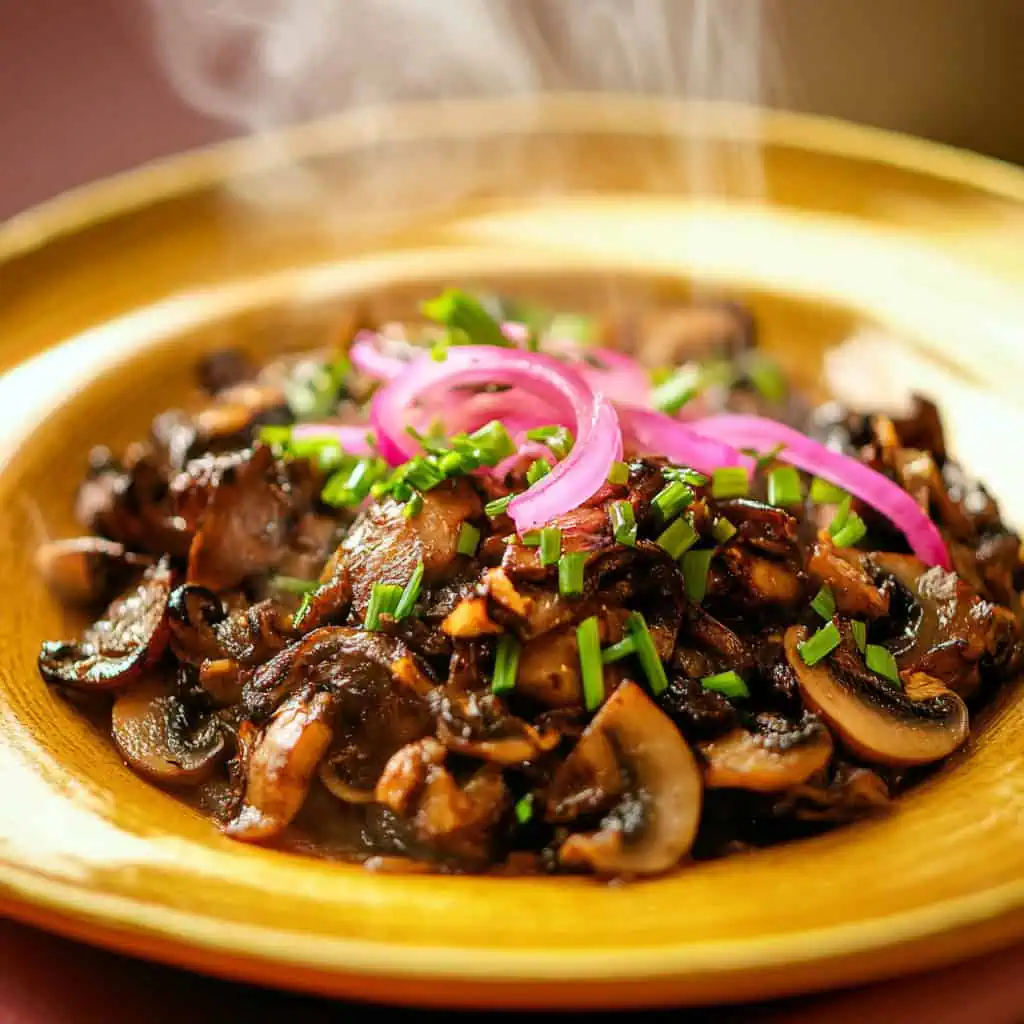

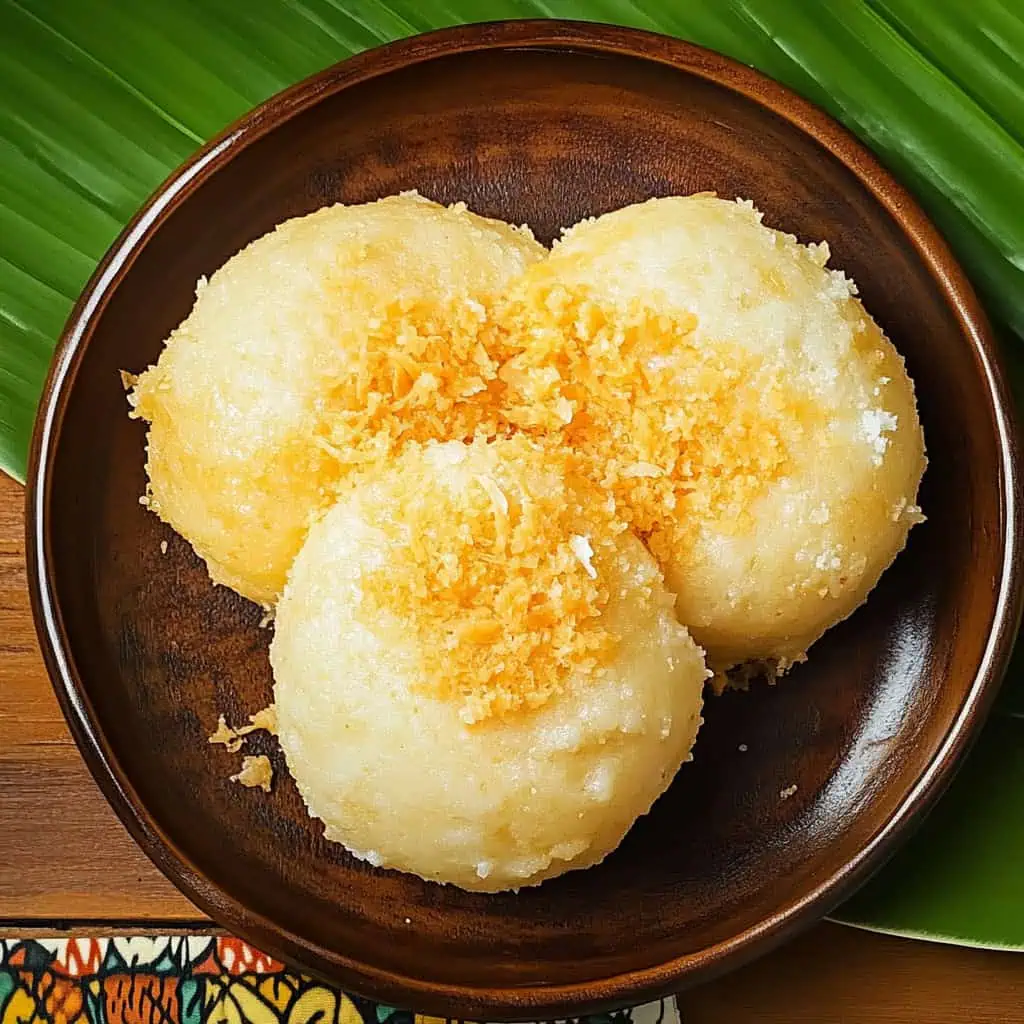
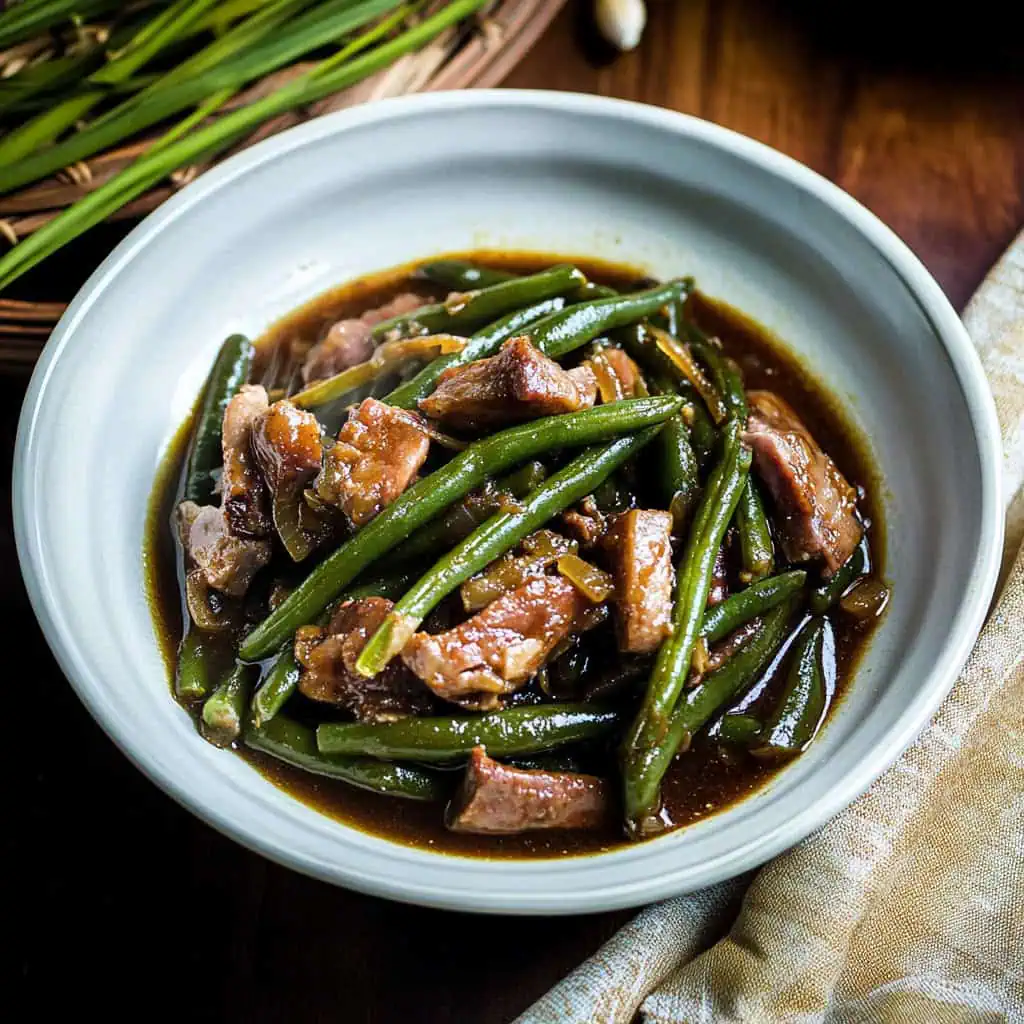
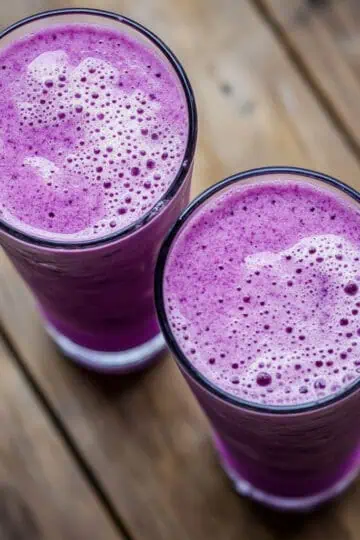
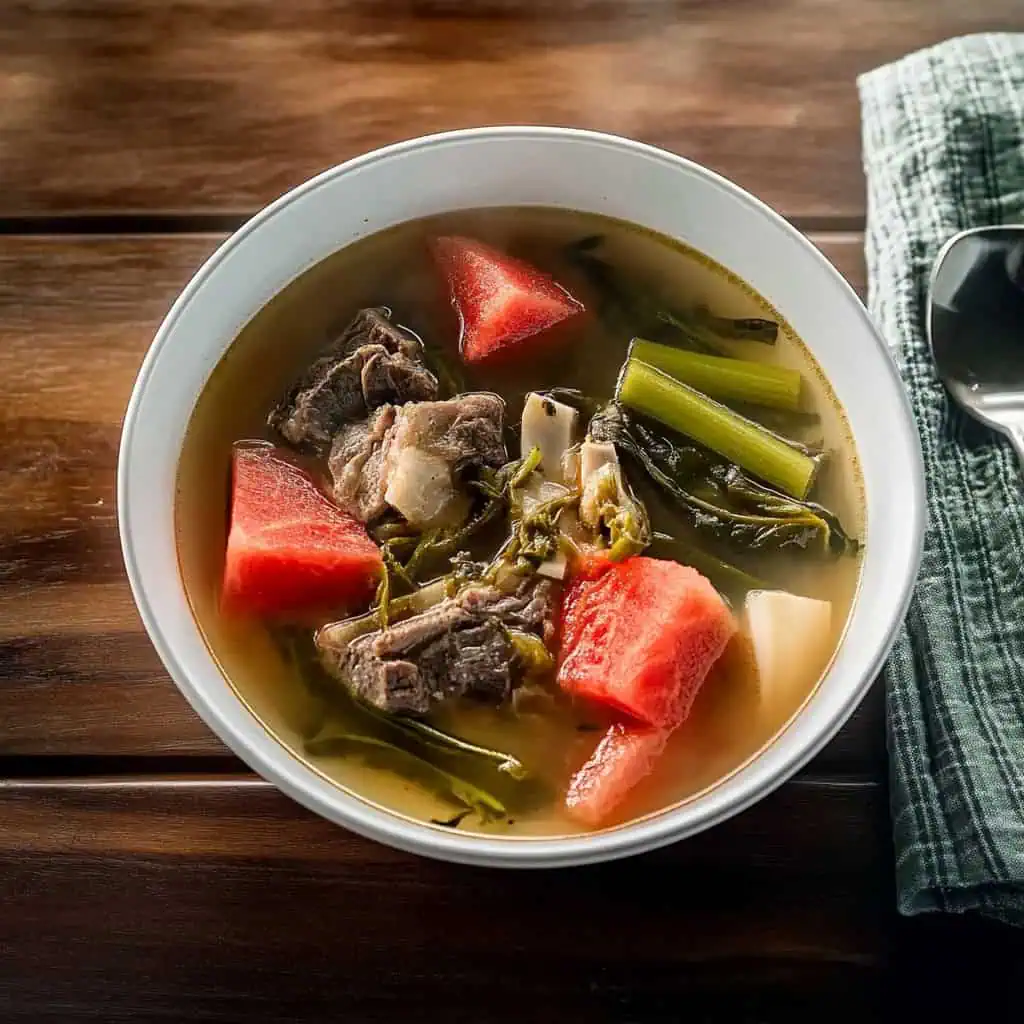

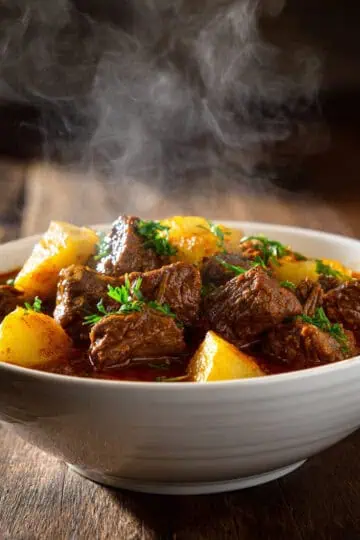
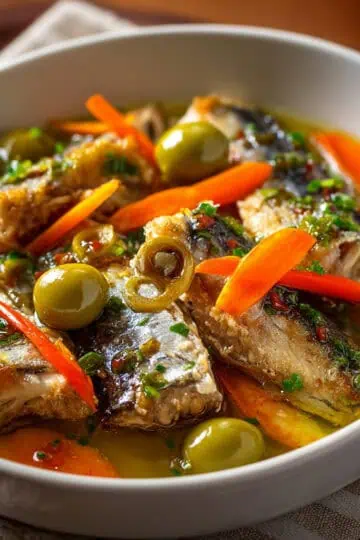

Comments
No Comments